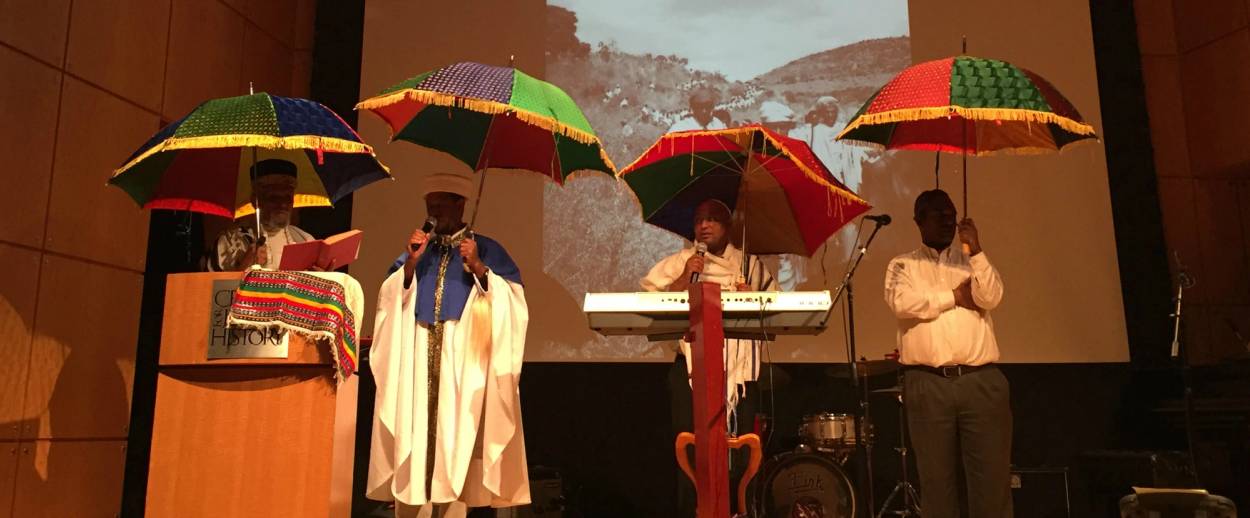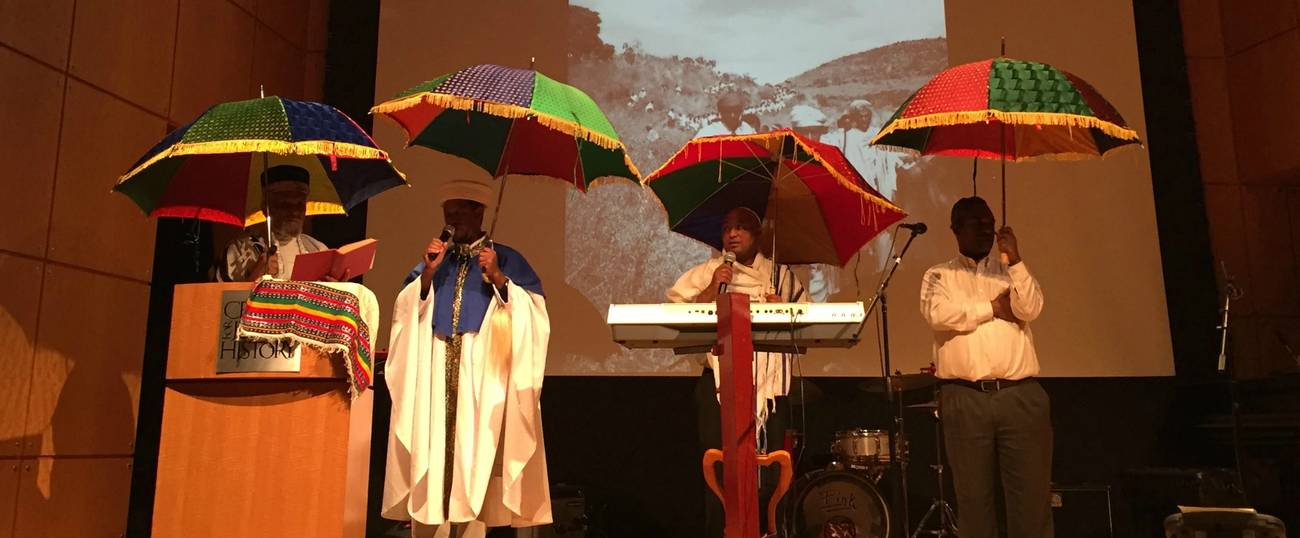Far From Home, New York’s Ethiopian Jewish Community Celebrates Sigd
Most Ethiopian Jews have left their homeland for Israel. But those in New York continue to practice their religious traditions.




On Sunday evening, about 200 people were greeted at Manhattan’s Center for Jewish History by the sound of a krar, an Ethiopian Jewish instrument that resembles a cross between a modern-day lyre and guitar. Attendees—everybody from New York’s elderly to younger Ethiopian Jews who have immigrated to the U.S. from Israel—appeared to have been mesmerized by the instrument’s sounds as they took to red-cushioned seats, ready for a night to remember.
The night’s festivities—North America’s sixth annual celebration of Sigd, an Ethiopian Jewish holiday—officially began when four men chanted in Ge’ez, an ancient Semitic language that developed in Ethiopia and Eritrea, as they carried large rainbow umbrellas made of fabric to the stage. When they arrived, two of them, both of whom were wearing a tallit, began to chant verses from the Bible, and other liturgy, in Ge’ez. The ritual display was followed by an address from two the worshipers—a Kes, meaning high priest or rabbi, and a professor—who shared the religious and communal significance of the holiday. As they explained, Sigd celebrates the date on which the Second Temple in Jerusalem was inaugurated, as is delineated in the Biblical books of Ezra and Nehemiah.
Traditionally in Ethiopia, before the majority of the Jewish population there left, the holiday began with a fast on the 50th evening after Yom Kippur. In the morning, the entire Jewish community congregates at the highest mountaintop. According to Ephraim Isaac, a professor of Semitic languages and Ethiopian history who serves as director for the Institute of Semitic Studies at Princeton University, this took place at four or five mountaintops around Ethiopia around which the Jewish communities lived. They would then stand on the mountain praying and reading sections of the Torah for hours. When they descended, they would go back to their village and enjoy festivities, including barbecued meat, live music, and dancing. According to Kes Vanda Eli Menntessnout, Sigd falls into the same class of holiday as rabbinic Jewish holidays like Hanukkah and Purim. The community holds the inauguration of the Second Temple in high esteem because, as Isaac put it, if “Jews around the world fast on a day known as Tisha B’Av”—the day on which tradition holds that both Biblical temples were destroyed—”isnt it strange that we fast then…[but] we do not celebrate the day that was given to us?”
Chassida Shmella, an organization that raises awareness about Ethiopian Jewry to preserve its rich culture, helped to produce the event along with the American Jewish Historical Society. Now that most Ethiopian Jewish community has moved to Israel, they perform a pilgrimage to Jerusalem’s Old City on the 29th of the Hebrew month of Cheshvan, annually. They still enjoy communal celebrations, barbeques, singing, and dancing, and in 2008, Sigd was officially made a national holiday in Israel. Bizu Riki Mullu, the founder of Chassida Shmella said, “In Ethiopia we celebrated to remember Moses going up the mountain and to pray to return to Israel.” Now, in North America, she explained, they continue the celebrate as best they can even though the rituals haven’t necessarily been “adapted” for those in the community celebrating outside of Israel or Ethiopia.
After learning about the history of the holiday and watching the aforementioned replications of ancient rituals, attendees enjoyed a kosher, traditional Ethiopian dinner that consists of a sort of spongy flatbread made from teff flour called injera, misir wot (spicy red lentils), a lentil-based stew, white rice, and another cold lentil dish called adashim. The contingency of Ethiopian Jews present enjoyed showing novices how to eat it, too, putting the lentil dishes and rice in the injera and eating it only with the right hand.
But the celebration was also a bit bittersweet. “We celebrate here, but not like in Israel [or Ethiopia],” explained Imanuel Alamo, 35, who now lives in Brooklyn with his wife and children. The small community of expat Ethiopian Jews in the New York City area has grown steadily in the last 3-4 years, Alamo estimated, with small communities peppering Brooklyn and Queens. His children have no memories of Sigd in Israel, he explained, and he said he wants them to grow up being familiar with it in some communal setting “so our kids don’t forget.” Though he and his community do not keep the same rituals as Ethiopian Jews do in Israel, or as they once did in his native Gonder, Ethiopia, he said he still feels Sigd’s importance even though there is no mountain to ascend nor an opportunity to engage in hours of ritual prayer and chanting. “It is important,” he said. “It brings everyone together. Here, the holiday is more cultural than religious.”
Previous: Ethiopian Mass Aliyah To End in August
Related: Unabsorbed
Israel Says There Are No More Jews in Ethiopia. Thousands Left Behind Disagree.
Rachel Delia Benaim is a freelance religion reporter. Her work has appeared in The Washington Post, The Daily Beast, and The Diplomat, among others. Follow her on Twitter @rdbenaim.